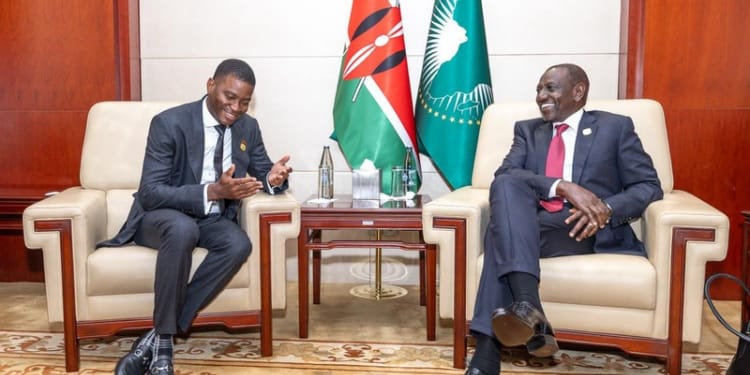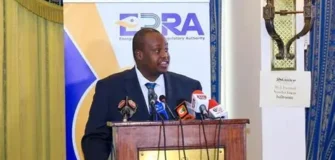What Has President Ruto Achieved in His First Three Years as President?
Share
President William Ruto has marked three years since he took over from Uhuru Kenyatta on September 13, 2022.
Government Spokesperson Dr. Isaac Mwaura has given an elaborate statement outline the achievements of Ruto’s administration during this period.
Here is the full statement:
1. We come once again this Monday morning to speak to you about the many achievements that the government has been able to deliver over the last three years as we continue to commemorate the three years that His Excellency President William Ruto has served as the fifth president.
He was sworn in on 13th September 2022 at a colourful ceremony here in Nairobi, attended by many heads of state and government, including all seven heads of state within the East African Community.
2. There are promises that we made, and through the Better Plan, which has now been turned into the Medium-Term Plan 4 of the Kenya Vision 2030, five pillars are critical in terms of ensuring the success of our country and keeping our development progressing into the future.
3. As you may be aware, we took over a dilapidated economy. Many sectors were on their knees. In fact, some people expected that we wouldn’t last three months without the economy collapsing. We are glad that we have been able to turn around the economy to the benefit of Kenyans as follows.
4. The government has made considerable progress in transforming the lives of ordinary Kenyans through its Bottom-Up Economic Transformation Agenda, popularly known as the Better Plan.
This year marks the third anniversary of the Kenya Kwanza administration, now a broad-based government, where considerable progress has been reported in the areas of agriculture, healthcare, housing, small businesses, and
the digital and creative economy.
Agriculture and Farmer Support
5. To begin with, in the agriculture sector, there has been a significant subsidy that reduced the cost of fertilizer from KSh 7,000 per bag to KSh 2,500, a reduction of KSh 5,000. This has translated into billions of shillings saved for Kenyans.
Additionally, support has been extended to farmers of edible oils, rice, nuts, cotton, and pyrethrum, thereby reducing household spending.
6. To date, 7 million farmers have been registered in the digital database, and 21 million bags of fertilizer distributed countrywide. As a result, farmers’ earnings have increased significantly: coffee by 52%, tea by 40%, and sugar by 76%.
For example, the average price of coffee per kilo is now KSh 120, with some cooperatives paying as high as KSh 150. Tea is trading at about KSh 64 per kilo, while sugar prices have risen from KSh 4,000 to KSh 5,500 per metric ton. These are critical gains that are transforming the lives of farmers.
7. In Nakuru, for instance, we witnessed how pyrethrum farming is reviving livelihoods.
We met Mr. and Mrs. Gitao of Njoro, whose lives have been transformed by the revitalization of the pyrethrum processing factory. These are the deliberate efforts geared towards achieving guaranteed minimum returns for farmers, as promised.
Jobs, Businesses, and Industrialization
8. On jobs, loans, and opportunities, 2.25 million small businesses have been formalized, while 31 constituency industrial development centers have been upgraded.
These efforts have created over 9,000 jobs, giving young people greater access to employment. Cold storage facilities, incubation hubs, and county trade fairs have opened up new markets for young entrepreneurs.
9. We also have functional digital hubs across the country, well stocked with computers and internet. Just this past weekend in Embu, we saw the impact first-hand. Young people are earning significant incomes—one of them even shared how he made KSh3 million in a short time. These hubs are proof that industrialization, combined with the digital superhighway, is creating opportunities.
10.Over 13 counties are at advanced stages in setting up agricultural industrial parks, like the one in Sagana, Kirinyaga County, which is already doing extremely well.
Others, such as in Homa Bay, are similarly well established. By combining county industrial development centers with digital marketing platforms, Kenya is expanding its manufacturing footprint. More young people are working remotely as virtual assistants for international companies, thanks to internet connectivity.
Affordable Housing
11.In affordable housing, 161,911 housing units are under construction, a tremendous increase from the 8,872 units in 2022. This progress has created more than 330,000 jobs in the construction and dual academy sectors. KSh 4.4 billion has been invested in training artisans, with over 1,000 certified to supply building materials. A total of 3,855 new mortgages have been issued at lower interest rates, making home ownership more accessible.
12.The program is also supporting thousands of suppliers -cement, steel,- sand, artisans (fundis) and transporters. Across the country, Kenya is a construction site. From Thika Road near TRM to Ruiru, Kapsabet, Laikipia, and even Northern Kenya, affordable housing projects are visible.
These planned neighborhoods are the solution to fragmentation, and they have been praised internationally. Recently, during the Rema Fest, Joshua Selman from Nigeria commended the thousands of units in Kibera as a truly transformational program.
13.These houses are for all Kenyans, teachers, police officers, civil servants, salaried and unsalaried workers. Globally, it is unheard of to own an apartment for KSh 1–2 million. Despite challenges at the start, we are on course to deliver the promised 200,000 units per year. Already, 161,000 are under construction, with over 700,000 more in planning.
14.The housing program has also created opportunities for women and youth. Young women’s participation has been increased from 20% to 30%, while 4,000 engineering internship placements are giving graduates their first experience in government.
15.Content creators are telling the housing story, while new hostels and student accommodation facilities are ensuring dignity in learning institutions. The President has already launched housing projects at Tom Mboya University, Embu University, and many more Universal Healthcare (UHC)
16.In healthcare, under the new Social Health Authority—Taifa Care—25.8 million Kenyans have been registered, a sharp rise from 8 million in 2022.
This demonstrates expanded access and availability of services. The government is also registering indigent households, ensuring nobody is left behind.
17.The Ministry of Health has recruited and trained 107,000 community health promoters, established cancer treatment centers, and screened millions for chronic diseases. Since 2022, over 350 hospitals have been built or upgraded, in partnership with counties, and 10,582 facilities have been digitized. Over KSh 68 billion has been disbursed under Taifa Care, with KSh 13 billion allocated to primary health care and KSh 10 billion to emergency and critical care. For the first time in history, every Kenyan now has a chance at healthcare coverage
Digital Superhighway and Creative Economy
18.In the digital superhighway and creative economy, cheaper internet, enhanced government service access, and new jobs are driving transformation. Locally assembled smartphones have lowered device costs, while 834 studio recordings have supported creative talent. Nearly 300,000 digital jobs have been created through ICT training.
19.Over 40,000 kilometers of fiber cable have been laid, enabling 1,578 public Wi-Fi hotspots and 404 digital hubs. More than 21,000 government services have been digitized, raising government collections to between KSh 700 million and 1 billion daily up from just KSh 60 million. These funds are now available for better services to Kenyans.
20.Education has also advanced, with TVET enrollment rising from 340,713 in 2022 to over 718,000 today. In mining, three laboratories have been established, and artisanal cooperatives registered. For the first time, a gold refinery is nearing completion at Ikolomani in Kakamega, ensuring local communities benefit directly.
Foreign and Diaspora Relations
21.In foreign and diaspora relations, more than 200 agreements have been signed, strengthening bilateral ties. Diaspora remittances reached KSh 660 billion, about USD 5 billion, with 85% supporting households in villages. This surpasses tea and coffee as Kenya’s highest income earner. The President has directed that this be scaled to KSh 1 trillion. Agreements with Saudi Arabia, Germany, the UK, and others are ensuring fair terms for Kenyan workers abroad.
Tourism and Wildlife
22.Tourism and wildlife are also booming. During the high season, tour operators are fully booked, generating KSh 462.21 billion in revenue. Kenya received 2.42 million international arrivals, alongside over 5 million domestic tourists. Just at KICC, thousands of schoolchildren are experiencing Nairobi’s heritage.
The Electronic Travel Authorization (ETA) has made Kenya more accessible, and the sector is projected to surpass 5 million international arrivals in the near future.
The government remains steadfast in turning its promises into tangible results for a stronger, inclusive, and more prosperous country.

Kenya President William Ruto during a meeting with Grenada Prime Minister Dickon Mitchell on the sidelines of the second Africa-CARICOM Summit, Addis Ababa, Ethiopia. PHOTO/PCS.
You Might also Like



Related Stories
Next Up












